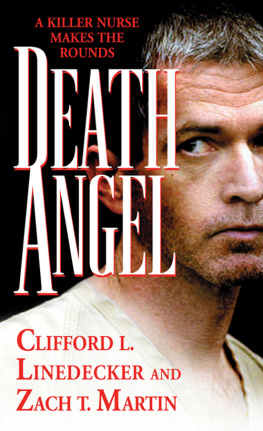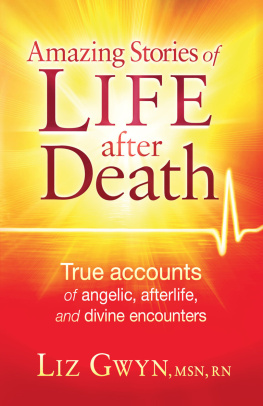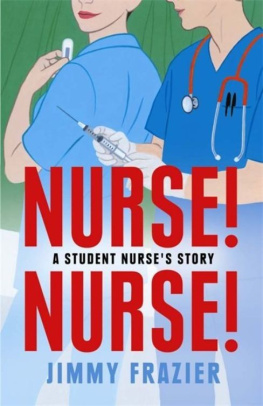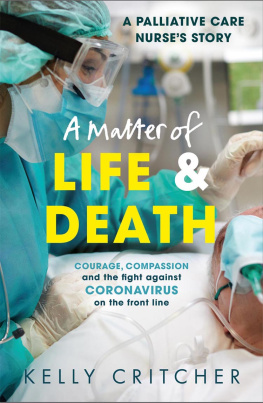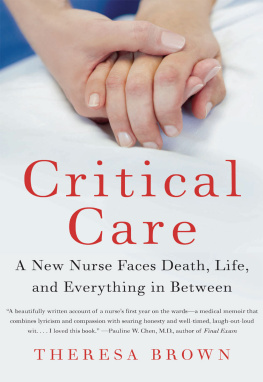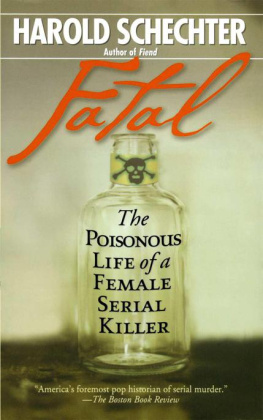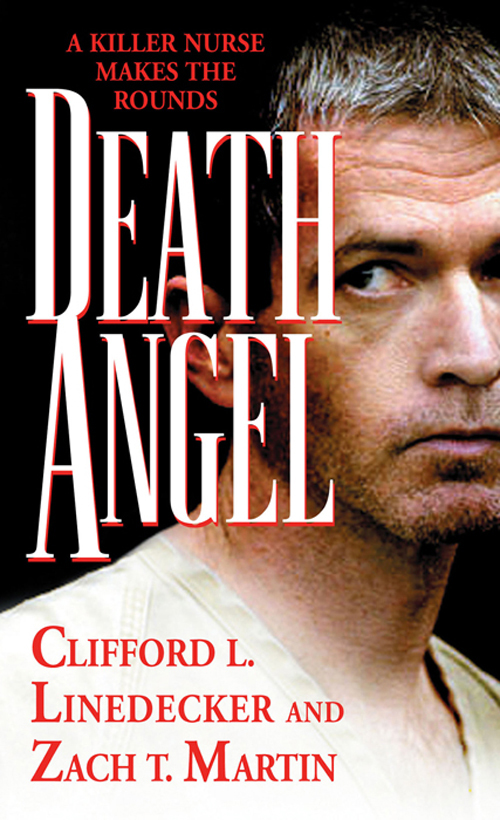Afterword
Charles Cullen was no master criminal like fabled safecracker Willie Sutton or international swindler, Victor Lustig, who twice sold the Eiffel Tower to scrap dealers, then topped off his career by audaciously bamboozling Chicago crime boss Al Capone out of $5,000. He wasnt even a brilliant archfiend like the fictional Professor Moriarty, who was locked in epic battles of wits with supersleuth Sherlock Holmes.
He was a pathetic, mentally addled, lifelong loser who was in and out of psychiatric hospitals and mental-health clinics, couldnt commit suicide despite more than twenty attempts, couldnt pay his billsalthough he earned a better annual salary than most middle-class Americans, couldnt keep his marriage together, and committed so many glaring blunders during his lethal career as a health-care killer that he might just as well have signed his name in blood on the bodies of his victims.
Yet, while sprinkling a trail of evidence as clear as Hansel and Gretels bread crumbs (before they were gobbled up by birds), he managed to maintain a killing career that spanned nearly sixteen years and claimed a still-unknown number of lives before he was stopped and brought to justice. Cullen was probably truthful when he told Detective Baldwin two days after his arrest that he thought he wanted to be caught.
He knew when he was the only nurse on duty on a particular ward and stole medications or poisoned patients on his shift, and when he used his nurses ID number to tap repeatedly into the Pyxis device to obtain unauthorized medications, that he was leaving glaring catch me signals in his trail. I knewI knew that they kept permanent records, and I knew that even if I entered it, that they would see those entries, he said of the Pyxis thefts during his lengthy interview with Braun and Baldwin.
Cullen was also aware he was leaving his fingerprints behind when he stole, then tossed away large amounts of medications at St. Lukes. He didnt bother to use rubber gloves while helping himself, even though he knew that his fingerprints were on file with law enforcement authorities as a result of his arrest and conviction in the stalking inci-dentway back in 1993. They had my fingerprints. I didnt try and disguise my fingerprints, he said.
He was suspected of underhanded behavior by authorities at three or four hospitals, he told the sleuths, and they didnt do anything.
A confessed serial killer with a record of psychiatric breakdowns and suicide attempts may not be the most credible commentator about such things, but law enforcement agencies accumulated sufficient additional evidence to back up his observation. They showed that in all too many cases lax security measures, glaring lapses of judgment, and professional cowardice contributed to the tragedy. When he was finally fired, forced to quit, or anything else was done to protect patients and stop the slaughter, it was usually too little or too late.
A prosecutor told reporters there was no evidence that accomplices assisted or joined in with the malignant nurse during the extended murder spree, but that doesnt mean there isnt an excess of blame to go around. Trial lawyers, teamed up with survivors of known and suspected victims, are already working on that aspect of the case. But inflicting collateral financial damage on institutions that may or may not be found to have been legally negligent for contributing to the dreadful carnage wont bring the dead back to life or prevent another Death Angel from following in Cullens bloody footsteps. Somewhere in the United States a homicidal nurse is probably killing hospital or nursing-home patients today.
ICU nurses play a unique frontline role in caregiving, and they must make decisions that people in few other professions are expected to make. There are times when terminally ill patients enduring intense agony can be helped only by being given pain-relieving medications that may include side effects that could hasten death. Nurses, not doctors, are the individuals who spend the most time with patients and are the closest witnesses to suffering. Providing adequate pain relief permitted by the treatment plan worked out by physicians is one of the main roles of critical-care nurses. But in their efforts to alleviate suffering, they must exercise great care not to violate stringent rules of conduct set in place to protect the lives of patients.
Sometimes, unfortunately, like the nurses in the Pennsylvania University study who admitted hastening the deaths of some patients, they stray over the line and make decisions they have no legal or ethical right to make. At the time of Cullens arrest there were about 2.7 million nurses in the United States, but it takes only a few renegades who abuse their position of trust to sully the reputation of an entire profession. It only took one to claim the lives of Eleanor Stoecker, Father Gall, Ottomar Schramm, Helen Dean, and more than twenty other patients.
Critical-care nurses working with the most seriously ill patients sometimes burn out, but when they burn out, they should get out. Was burnout from the emotional pressures and high-level responsibilities of accepting an assignment to a burn unit on Cullens very first job as a nurse to blame for his horrendous behavior? Who knows? He already had tried suicide at least twice, was ushered out of the navyprobably with a medical or less than honorable dischargeand his tenuous hold on sanity was frayed and fried long before he ever enrolled in nursing school.
Considering the fragile state of Cullens mental health, he was not the best candidate for handling the enormous responsibilities of being a critical-care nurse that he experienced throughout his sixteen-year career as an RN. It is difficult for families who lost relatives to Cullens murderous rampage, and for just about anyone else who is paying attention, to understand how employers could close their eyes to psychotic episodes and suicide attempts by the troubled RN and permit him to continue working with critically ill patients.
When he attempted suicide after stalking his fellow RN, he was treated by colleagues in the emergency room at the same hospital he worked in, before being sent off for treatment at a mental-health clinic and a psychiatric hospital. Two months later he was back working at Warren, presumably because the hospital didnt dare discriminate against someone with mental problems. Would one of his employers intervene finally if he was caught naked and howling at the moon? survivors might have asked.
Cullen should have been recognized for what he was years before he ever worked his first night shift at the Somerset Medical Center. He didnt just emerge out of the blue as a bizarre new kind of serial predator when he murdered his first patient at St. Barnabas, or slaughtered whole strings of patients at St. Lukes and at Somerset Medical Center. Hospital homicides are not isolated aberrations, and Cullens kind of self-appointed executioners in white have been with us for a long time. Donald Harvey, Orville Lynn Majors, Richard Diaz and baby-killer Genene Jones provided grim proof of that long before Cullen publicly emerged on the scene. Employed in south Texas during the early 1980s, Nurse Jones overdosed babies with medications and basked in the attention she attracted while working over the tiny forms during code-blue emergencies. Everyone in a position of authority in the health-care business, hospital workers and nursing-home administrators and supervisors, directors of regulatory agencies, professional nursing associations, and others knew about health-care killersor they should have known.

